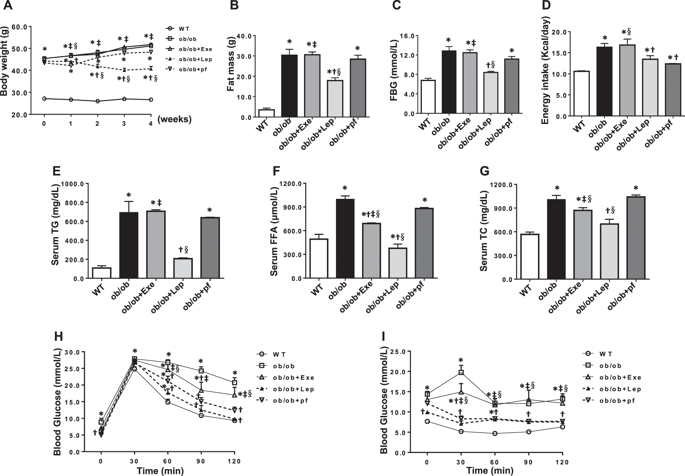International Journal of Obesity ( IF 4.2 ) Pub Date : 2020-01-07 , DOI: 10.1038/s41366-019-0513-y Fen Xu 1, 2 , Huanyi Cao 1, 2 , Zonglan Chen 1, 2 , Huimin Gu 1, 3 , Wanrong Guo 1, 2 , Beisi Lin 1, 2 , Jianping Weng 1, 2

|
Objective
Ectopic lipid deposition is closely associated with type 2 diabetes (T2D). Accumulating evidence shows that GLP-1 receptor agonists (GLP-1 RAs) improve obesity and liver steatosis. However, it remains unknown whether and how they ameliorate lipid deposition in skeletal muscle. This study aimed to investigate the effect of exenatide (a GLP-1 RA) on intramyocellular lipid deposition in the skeletal muscle of T2D models and its dependence on weight loss.
Methods
Ob/ob mice and diet-induced obese (DIO) mice were treated with exenatide (24 nmol/kg), leptin (1 mg/kg), or saline control intraperitoneally once daily for 4 weeks. Phenotypic evaluations were performed during and after the intervention. PA-induced myoblast C2C12 cells were used as an in vitro model. The expression of key enzymes involved in lipid metabolism was assessed in the skeletal muscle of ob/ob mice and DIO mice.
Results
In ob/ob mice, 4-week exenatide treatment did not improve the body weight and fat mass, but modestly ameliorated intramyocellular lipid deposition and lipid profiles. In DIO mice, it remarkably alleviated the body weight, lipid profiles, and intramyocellular lipid deposition. In the skeletal muscle of these two models, exenatide treatment activated the AMP-activated protein kinase (AMPK) signaling pathway, stimulated lipid oxidation enzymes, and upregulated the insulin signaling pathway. In vitro, exendin-4 activated the AMPK signaling pathway and stimulated lipid metabolism to improve lipid accumulation in palmitate-induced myoblast C2C12 cells.
Conclusions
Exenatide ameliorated intramyocellular lipid deposition without body weight reduction in ob/ob mice, but alleviated body weight and intramyocellular lipid deposition in DIO mice. The underlying mechanism included the activation of AMPK signaling pathway and improvement in insulin sensitivity, independent of weight loss in ob/ob mice.
中文翻译:

短期 GLP-1 受体激动剂艾塞那肽可改善肌细胞内脂质沉积,但 ob/ob 小鼠体重不减轻
客观的
异位脂质沉积与 2 型糖尿病 (T2D) 密切相关。越来越多的证据表明,GLP-1 受体激动剂 (GLP-1 RAs) 可改善肥胖和肝脏脂肪变性。然而,尚不清楚它们是否以及如何改善骨骼肌中的脂质沉积。本研究旨在研究艾塞那肽(一种 GLP-1 RA)对 T2D 模型骨骼肌中肌细胞内脂质沉积的影响及其对体重减轻的依赖性。
方法
Ob/ob 小鼠和饮食诱导的肥胖 (DIO) 小鼠每天一次用艾塞那肽 (24 nmol/kg)、瘦素 (1 mg/kg) 或盐水对照进行腹膜内治疗,持续 4 周。在干预期间和之后进行表型评估。PA诱导的成肌细胞C2C12细胞用作体外模型。在 ob/ob 小鼠和 DIO 小鼠的骨骼肌中评估了参与脂质代谢的关键酶的表达。
结果
在 ob/ob 小鼠中,4 周的艾塞那肽治疗并未改善体重和脂肪量,但适度改善了肌细胞内脂质沉积和脂质谱。在 DIO 小鼠中,它显着减轻了体重、脂质分布和肌细胞内脂质沉积。在这两种模型的骨骼肌中,艾塞那肽治疗激活了 AMP 活化蛋白激酶 (AMPK) 信号通路,刺激了脂质氧化酶,并上调了胰岛素信号通路。在体外,exendin-4 激活 AMPK 信号通路并刺激脂质代谢,以改善棕榈酸酯诱导的成肌细胞 C2C12 细胞中的脂质积累。
结论
艾塞那肽改善了 ob/ob 小鼠的肌细胞内脂质沉积,但没有减轻体重,但减轻了 DIO 小鼠的体重和肌细胞内脂质沉积。潜在机制包括 AMPK 信号通路的激活和胰岛素敏感性的改善,与 ob/ob 小鼠的体重减轻无关。











































 京公网安备 11010802027423号
京公网安备 11010802027423号